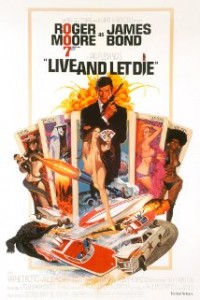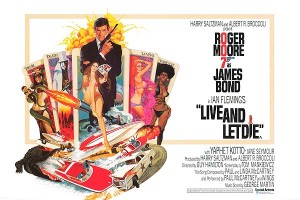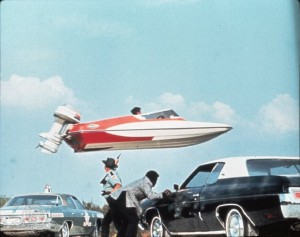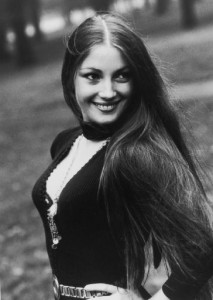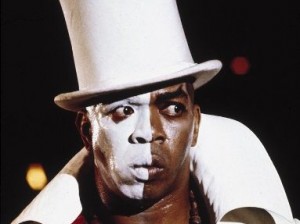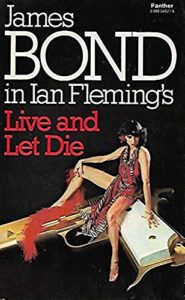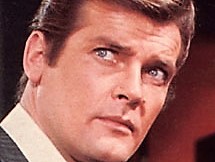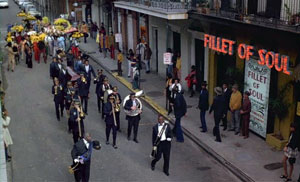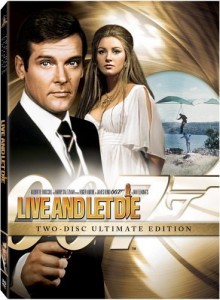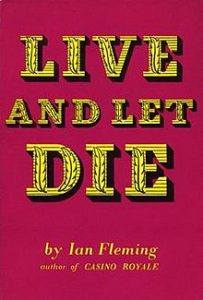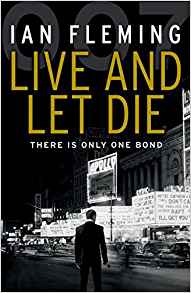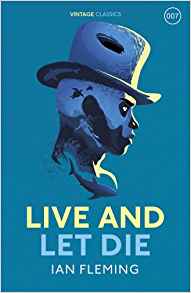Live and Let Die **** (1973, Roger Moore, Yaphet Kotto, Jane Seymour, Clifton James, Julius Harris, Geoffrey Holder, Gloria Hendry) – Classic Movie Review 1022
Directed by Guy Hamilton in 1973, Roger Moore’s debut film as British Secret Service agent 007 is one of the best of his series of seven Bond movies. Live and Let Die is the eighth in the Eon Productions official film series. It opens in Jamaica, poignantly the location for Dr No whence it all started, where 007 battles voodoo practitioners and drug runners.
When British agents are reported murdered, James Bond is sent to New Orleans to investigate. He finds he has to go through marshy grass and on water to put out of action the diabolically brilliant heroin magnate Dr Kananga, aka Mr Big, at the bottom of it all.
With its blaxploitation movie era drug trafficking plot, Live and Let Die is a splendidly exotic and thrilling caper from start to finish, with a full complement of exciting chases, fabulous eye-catching locations (Manhattan, Harlem, New Orleans, Louisiana and the Caribbean Islands) and high-class Bond beauties, including (and especially) a lovely young Jane Seymour as the fortune-telling Solitaire, a reliable psychic tarot card reader. It’s the first Bond film featuring an African American Bond girl to be romantically involved with 007, Rosie Carver, played by Gloria Hendry.
The boat chase through the bayous was written in the script as ‘Scene 156 – The most terrific boat chase you’ve ever seen’ – and the film-makers really deliver. Bond’s speedboat jump made it into the Guinness Book of World Records for its distance of 110 feet, a record that stood for three years.
It helps a lot that there are many eye-catching performances featuring actors relishing exotic roles. Yaphet Kotto and Clifton James are exceptionally lively and memorable as Dr Kananga, the voodoo-villain Prime Minister of San Monique in the Caribbean, and the soppy redneck Southern Sheriff Pepper. Julius Harris makes a memorable villain in Tee Hee, his right arm severed by a keen crocodile and his hand replaced by a claw, while Geoffrey Holder scores as the villainous top-hatted voodoo master henchman Baron Samedi.
Of course, with the genial Moore as 007, it is a different kind of Bond from the Sixties model, and much more of a Seventies-style comic cartoon version of a Bond movie than in the Sean Connery era. Yet still it is no less enjoyable for that, with serious spying put on hold for Moore’s tenure in the role.
Bond himself is a bit different too: he drinks bourbon whiskey instead of a vodka Martini, he smokes cigars instead of cigarettes, he doesn’t wear a hat (Moore even performs the gun-barrel sequence hatless) and the mission briefing occurs in his apartment not the office (Bond’s flat is seen for the second and so far final time in the series).
Happily M (Bernard Lee) and Miss Moneypenny (Lois Maxwell) are present and correct, but sadly there is no Q, and he is much missed. This and Dr No are the only two Bond films without Desmond Llewelyn until his death in 1999.
Paul and Linda McCartney wrote the excellent, catchy Oscar-nominated hit title song, performed by their band Wings, who scored a chart hit with it. Producer Harry Salzman preferred Brenda Arnau’s version of the song, also heard in the movie.
The incredibly stylish and iconic title design is by Maurice Binder.
Also in the cast are Roy Stewart, Madeline Smith, Tommy Lane, Earl Jolly Brown, Lon Satton, Arnold Williams, Ruth Kempf, Joie Chitwood, Michael Ebbin, Kubi Chaza, Brenda J Arnau, Robert Dix, Dennis Edwards, Lance Gordon, Stephen Hendrickson, Don Topping and Gabor Vernon.
Geoffrey Holder, 6ft 6ins, died on October 5 2014, aged 84. He first played the role of Baron Samedi in House of Flowers, a Caribbean-themed Broadway musical. [Spoiler alert] Samedi is shot and thrown into a coffin of venomous snakes by Bond but appears in a final scene at the back of a train at the end credits, having presumably used his supernatural powers to cheat death.
Live and Let Die is Ian Fleming’s second James Bond novel, first published in the UK by Jonathan Cape on 5 April 1954. Drawing on his local knowledge, he wrote it at his Goldeneye estate in Jamaica before his first book, Casino Royale, was published. There are now two films of it, Casino Royale (1967) and Casino Royale (2006).
© Derek Winnert 2014 Classic Movie Review 1022
Check out more reviews on http://derekwinnert.com/

